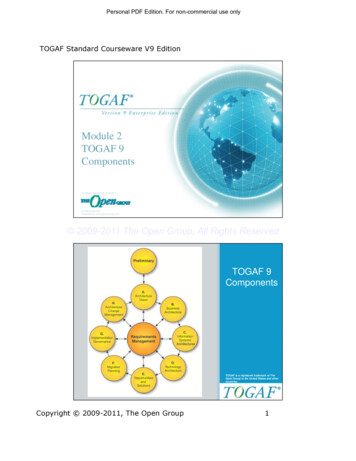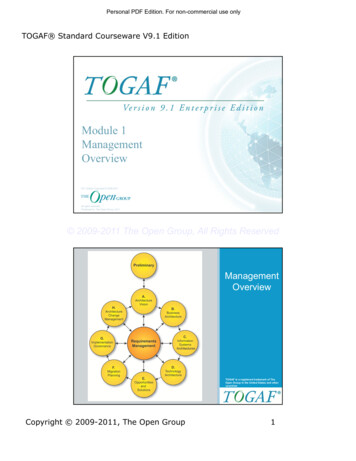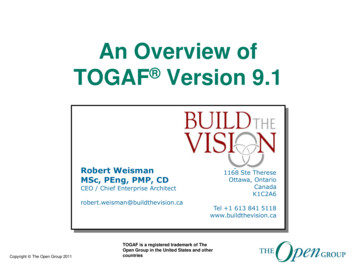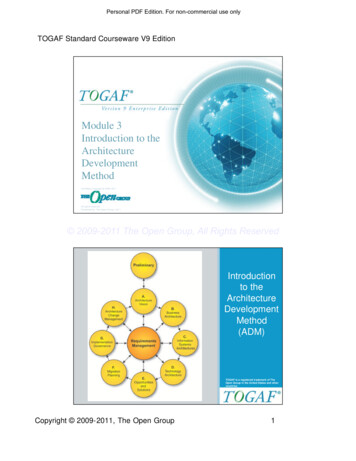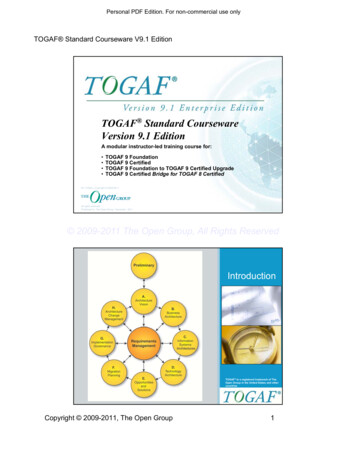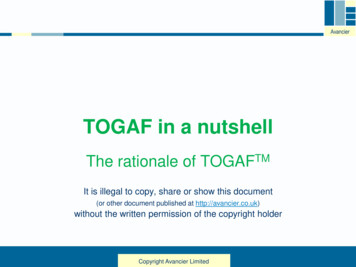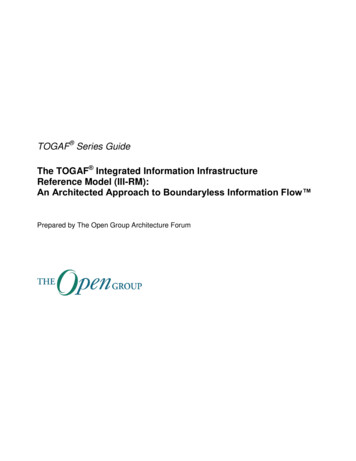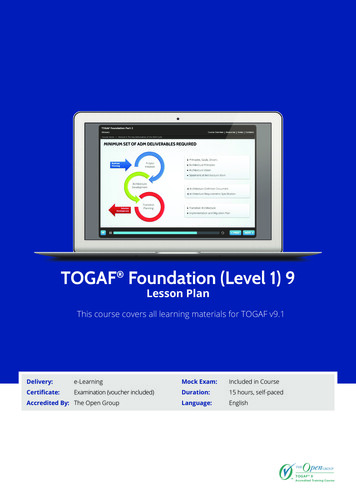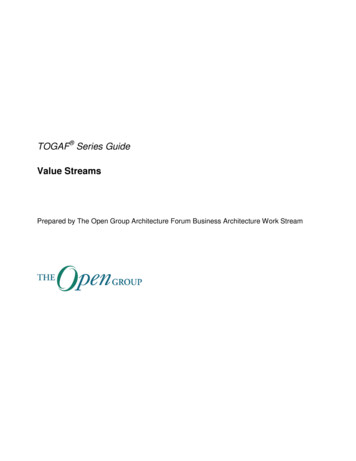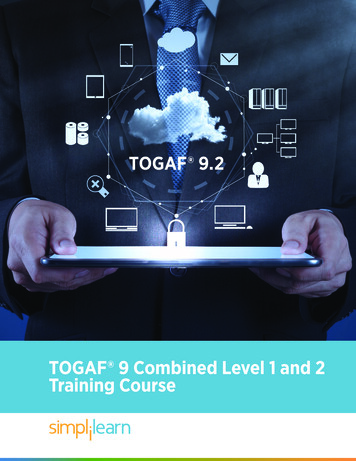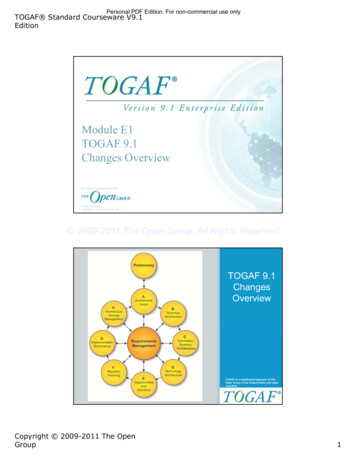
Transcription
Personal PDF Edition. For non-commercial use onlyTOGAF Standard Courseware V9.1EditionModule E1TOGAF 9.1Changes OverviewV9.1 Edition Copyright 2009-2011Slide 1All rights reserved The Open Group 2011Published by The Open Group, 2011 2009-2011 The Open Group, All Rights ReservedTOGAF 9.1ChangesOverviewTOGAF is a registered trademark of TheOpen Group in the United States and othercountriesSlide 2 The Open Group 2011Copyright 2009-2011 The OpenGroup1
Personal PDF Edition. For non-commercial use onlyTOGAF Standard Courseware V9.1EditionAudience The audience for this module is– Enterprise architects, business architects, dataarchitects, systems architects, solutions architects andsenior managers seeking an overview of what haschanged between TOGAF 9 and TOGAF 9.1– A prior knowledge of TOGAF 9 is presumedSlide 3 The Open Group 2011c 2009-2011 The Open Group, All Rights ReservedModule Objectives To understand– The key changes between TOGAF 9 and TOGAF 9.1– The implications on the TOGAF 9 Certification programSlide 4 The Open Group 2011Copyright 2009-2011 The OpenGroup2
Personal PDF Edition. For non-commercial use onlyTOGAF Standard Courseware V9.1EditionAgenda TOGAF 9.1 Components andStructure TOGAF 9.1 Change Highlights TOGAF 9.1 Features Removed TOGAF 9.1 Features Revised TOGAF 9.1 and Certification Backup Slides– TOGAF 9.1 Detailed ChangesSlide 5 The Open Group 2011 2009-2011 The Open Group, All Rights ReservedTOGAF 9.1 TOGAF 9.1 was released in December 2011 It is the first maintenance update to TOGAF 9 It is an upwards-compatible evolution from TOGAF9, addressing usage feedback and commentsraised– It addresses over 400 comments received– Contains over 450 changes TOGAF 9 Technical Corrigendum 1 (DocumentU112) is available describing each change in detailSlide 6 The Open Group 2011Copyright 2009-2011 The OpenGroup3
Personal PDF Edition. For non-commercial use onlyTOGAF Standard Courseware V9.1EditionTOGAF 9.1 ComponentsSlide 7 The Open Group 2011 2009-2011 The Open Group, All Rights ReservedPart I - IntroductionPreface, Executive Overview, Core Concepts, Definitions andRelease NotesPart II – Architecture Development MethodIntroduction to ADMADM Phase NarrativesPart III – ADM Guidelines and TechniquesGuidelines for Adapting the ADM ProcessTechniques for Architecture DevelopmentPart IV – Architecture Content FrameworkContent MetamodelArchitectural ArtifactsArchitecture DeliverablesBuilding BlocksPart V – Enterprise Continuum and ToolsEnterprise ContinuumArchitecture PartitioningArchitecture RepositoryTools for Architecture DevelopmentPart VI – TOGAF Reference ModelsFoundation Architecture: Technical Reference ModelIntegrated Information Infrastructure Reference ModelPart VII – Architecture Capability FrameworkArchitecture BoardArchitecture ComplianceArchitecture ContractsArchitecture GovernanceArchitecture Maturity ModelsArchitecture Skills FrameworkSlide 8 The Open Group 2011Copyright 2009-2011 The OpenGroup4
Personal PDF Edition. For non-commercial use onlyTOGAF Standard Courseware V9.1EditionTOGAF 9.1 Change HighlightsEditorial improvements. Definitionsclarified. The DocumentCategorization Model removedPart I - IntroductionPreface, Executive Overview, Core Concepts, Definitionsand Release NotesPart II – Architecture Development MethodIntroduction to ADMADM Phase NarrativesPart III – ADM Guidelines and TechniquesGuidelines for Adapting the ADM ProcessTechniques for Architecture DevelopmentPart IV – Architecture Content FrameworkContent MetamodelArchitectural ArtifactsArchitecture DeliverablesBuilding BlocksPart V – Enterprise Continuum and ToolsEnterprise ContinuumArchitecture PartitioningArchitecture RepositoryTools for Architecture DevelopmentPart VI – Reference ModelsFoundation Architecture: Technical Reference ModelIntegrated Information Infrastructure Reference ModelPart VII – Architecture Capability ractsGovernanceMaturity ModelsSkills FrameworkEditorial improvements. Objectivessections reworked. Phases E and Fdescriptions reworkedEditorial improvements. SOA chapter revised to reflectlatest work in The Open Group. Introductory text onArchitectural styles added. The concepts oflevels/iteration/partitions have been clarified and madeconsistentCorrections have been made to the metamodel diagramsand to aspects of the metamodel. Reworked descriptionsof Architectural Artifacts and Viewpoints. The BuildingBlocks Example has been removedEditorial improvements. The Tools Evaluation Criteriaand Guidelines have been removed. The relationshipof the Architecture Repository to the EnterpriseRepository has been clarifiedNo changesMinor editorial ImprovementsSlide 9 The Open Group 2011 2009-2011 The Open Group, All Rights ReservedTOGAF 9.1: Material RemovedPart I - IntroductionPreface, Executive Overview, Core Concepts, Definitionsand Release NotesPart II – Architecture Development MethodIntroduction to ADMADM Phase NarrativesPart III – ADM Guidelines and TechniquesGuidelines for Adapting the ADM ProcessTechniques for Architecture DevelopmentPart IV – Architecture Content FrameworkContent MetamodelArchitectural ArtifactsArchitecture DeliverablesBuilding BlocksPart V – Enterprise Continuum and ToolsEnterprise ContinuumArchitecture PartitioningArchitecture RepositoryTools for Architecture DevelopmentPart VI – Reference ModelsFoundation Architecture: Technical Reference ModelIntegrated Information Infrastructure Reference ModelPart VII – Architecture Capability ractsGovernanceMaturity ModelsSkills Framework The DocumentCategorization Model hasbeen removed (Chapter 2) Definitions of terms whereusage is not distinctive fromthe common dictionarydefinition have beenremoved (Chapter 3) The Building Blocks examplehas been removed (chapter37) The Evaluation Criteria andGuidelines have beenremoved (Chapter 42)Slide 10 The Open Group 2011Copyright 2009-2011 The OpenGroup5
Personal PDF Edition. For non-commercial use onlyTOGAF Standard Courseware V9.1EditionTOGAF 9.1: Material RevisedPart I - IntroductionPreface, Executive Overview, Core Concepts, Definitionsand Release Notes Part II – Architecture Development MethodIntroduction to ADMADM Phase NarrativesPart III – ADM Guidelines and TechniquesGuidelines for Adapting the ADM ProcessTechniques for Architecture DevelopmentPart IV – Architecture Content FrameworkContent MetamodelArchitectural ArtifactsArchitecture DeliverablesBuilding Blocks Part V – Enterprise Continuum and ToolsEnterprise ContinuumArchitecture PartitioningArchitecture RepositoryTools for Architecture DevelopmentPart VI – Reference Models Foundation Architecture: Technical Reference ModelIntegrated Information Infrastructure Reference ModelPart VII – Architecture Capability ractsGovernanceMaturity ModelsSkills Framework The "Objectives" sections of theADM phases have been reworkedto focus on actual objectives ratherthan techniques or a list of steps(chaps 6-17)Phase E and F descriptions havebeen reworked to match the level ofdetail in other phases (chaps 13,14)The concepts of levels. Iterationsand partitions have been clarifiedand made consistent. (chaps19/20/40)Additional introductory text onarchitectural styles has been addedin Part III, Chapter 18The SOA chapter (Part III, Chapter22) has been updated to describethe latest work from The OpenGroupSlide 11 The Open Group 2011 2009-2011 The Open Group, All Rights ReservedTOGAF 9.1 and Certification The TOGAF 9 Certification for People Program has beendesigned to accommodate maintenance updates to theTOGAF 9 standard such as TOGAF 9.1 The two levels of certification remain as TOGAF 9Foundation and TOGAF 9 Certified Individuals who are currently certified in the TOGAF 9People Certification program remain certified The Conformance Requirements for TOGAF 9 Certificationhave been updated and will become mandatory on June 1,2012 All Accredited TOGAF 9 Training Courses will be updatedto the revised Conformance Requirements by June 1, 2012Slide 12 The Open Group 2011Copyright 2009-2011 The OpenGroup6
Personal PDF Edition. For non-commercial use onlyTOGAF Standard Courseware V9.1EditionTOGAF 9.1 and Certification In the period between December 1, 2011 and June 1, 2012candidates can study either to the original ConformanceRequirements or the revised Conformance Requirements The examinations have been designed to accommodateboth up to June 2013, which allows candidates up to twelvemonths after studying to take the exam The reference text provided with the Open Bookexaminations will remain TOGAF 9 until June 1, 2012 andwill then switch to TOGAF 9.1 after that dateSlide 13 The Open Group 2011 2009-2011 The Open Group, All Rights ReservedTOGAF 9.1 and CertificationDecember 1 2011June 1 2012Accredited TOGAF 9Training Courses cancover either TOGAF 9 or9.1 up to and includingMay 31 2012June 1 2013Accredited TOGAF 9Training Courses mustcover TOGAF 9.1 from June 1 2012The Examinations accommodate both TOGAF 9 and TOGAF9.1 until June 1 2013. The extended period allows forcandidates who study and obtain a 12 month exam voucherOpen Book Reference TextTOGAF 9The exam questionscan cover newTOGAF 9.1 materialfrom June 1 2013Open Book Reference Text changesto TOGAF 9.1 on June 1 2012Slide 14 The Open Group 2011Copyright 2009-2011 The OpenGroup7
Personal PDF Edition. For non-commercial use onlyTOGAF Standard Courseware V9.1EditionTOGAF 9.1Changes in Detail 2009-2011 The Open Group, All Rights ReservedTOGAF 9.1 Changes in Detail The Document Categorization Model has been removed (Section 2.8).Definitions of terms where usage by TOGAF is not distinctive from the common dictionarydefinition have been removed (Chapter 3).The usage of the terms “application” versus “system” have been reviewed and madeconsistent (global change).The “Objectives” sections of the phases have been reworked to focus on actual objectivesrather than techniques or a list of steps (Chapters 6-17).The possible artifacts (viewpoints) for each phase are now listed in the description of thatphase, not just in Part IV, Chapter 35: Architectural Artifacts (Chapters 6-17).Duplicate text in several places has been replaced with an appropriate reference:–– Gap Analysis in Phases B, C, and D now references Part III, Chapter 27: Gap Analysis (Chapters8,10,11,12).Requirements Management in several phases now references Part II, Section 17.2.2:Requirements Development in the Requirements Management phase (Chapters 8,10,11,12).The Phase E and F descriptions have been reworked to match the level of detail in otherphases (Chapters 13,14).The uses of terminology for Transition Architecture/Roadmap/Implementation Strategyhave been clarified and made consistent (Chapters 13,14).Slide 16 The Open Group 2011Copyright 2009-2011 The OpenGroup8
Personal PDF Edition. For non-commercial use onlyTOGAF Standard Courseware V9.1EditionTOGAF 9.1 Changes in Detail The concepts of levels/iterations/partitions have been clarified andmade consistent. This includes a reorganization of material in Part III,Chapter 19: Applying Iteration to the ADM, Chapter 20: Applying theADM across the Architecture Landscape, and Part V, Chapter 40:Architecture Partitioning (Chapters 5,19,20,40). Additional introductory text on architectural styles has been added inPart III, Chapter 18: Introduction (Chapter 18). Minor changes have been made to the Security Architecture chapter(Part III, Chapter 21: Security Architecture and the ADM) for consistencywith the ADM (Chapter 21). The SOA chapter (Part III, Chapter 22: Using TOGAF to Define &Govern SOAs) has been updated to describe the latest SOA WorkGroup output (Chapter 22).Slide 17 The Open Group 2011 2009-2011 The Open Group, All Rights ReservedTOGAF 9.1 Changes in Detail The description of Architecture Principles now divides them into two types only –Enterprise and Architecture – whereas before they called out IT Principlesseparately. IT Principles are now seen as just part of Enterprise Principles(Chapter 23).The Stakeholder Map included in the Stakeholder Management chapter (Part III,Chapter 24: Stakeholder Management) is now explicitly referred to as anexample, the table has been highlighted to refer to Stakeholder Concerns, andthe list of artifacts for each stakeholder updated (Chapter 24).The Business Scenarios chapter (Part III, Chapter 26: Business Scenarios andBusiness Goals) has been renamed to Business Scenarios and Business Goalsto better reflect the contents of the chapter (Chapter 26).Corrections have been made to metamodel diagrams (Chapter 34).Corrections have been applied to aspects of the metamodel (Chapter 34).The terms “artifact” versus “viewpoint” have been clarified and made consistent.This includes a restructuring of Part IV, Chapter 35: Architectural Artifacts(Chapter 35).Slide 18 The Open Group 2011Copyright 2009-2011 The OpenGroup9
Personal PDF Edition. For non-commercial use onlyTOGAF Standard Courseware V9.1EditionTOGAF 9.1 Changes in Detail Some of the artifacts have been renamed to better reflecttheir usage (Chapter 35):– System/Data matrix becomes Application/Data matrix– Class diagram has been replaced with Conceptual Data diagramand Logical Data diagram– System/Organization matrix becomes Application/Organizationmatrix– Role/System matrix becomes Role/Application matrix– System/Function matrix becomes Application/Function matrix– Process/System Realization diagram becomes Process/ApplicationRealization diagram– System Use-Case diagram becomes Application Use-Case diagram– System/Technology matrix becomes Application/Technology matrixSlide 19 The Open Group 2011 2009-2011 The Open Group, All Rights ReservedTOGAF 9.1 Changes in Detail The Building Blocks example has been removed (Chapter37). The relationship of the Enterprise Repository to theArchitecture Repository is clarified in Part V, Chapter 41:Architecture Repository (Chapter 41). The Evaluation Criteria and Guidelines have been removedfrom Part V, Chapter 42: Tools for ArchitectureDevelopment (Chapter 42). The chapter on Architecture Maturity Models (Part VII,Chapter 51: Architecture Maturity Models) has beeneditorially revised for consistency and clarity (Chapter 51).Slide 20 The Open Group 2011Copyright 2009-2011 The OpenGroup10
Personal PDF Edition. For non-commercial use onlyTOGAF Standard Courseware V9.1EditionFurther Reading TOGAF 9.1 Web Page– http://www.opengroup.org/architecture/togaf91/ White paper: An Introduction to TOGAF 9.1– m TOGAF 9 Technical Corrigendum 1– m TOGAF Information Web site– http://www.togaf.infoSlide 21 The Open Group 2011 2009-2011 The Open Group, All Rights ReservedTOGAF 9.1ChangesOverviewTOGAF is a registered trademark of TheOpen Group in the United States and othercountriesSlide 22 The Open Group 2011Copyright 2009-2011 The OpenGroup11
The Examinations accommodate both TOGAF 9 and TOGAF 9.1 until June 1 2013. The extended period allows for candidates who study and obtain a 12 month exam voucher The exam questions can cover new TOGAF 9.1 material from June 1 2013 Open Book Reference Text changes to
